
The conversion of
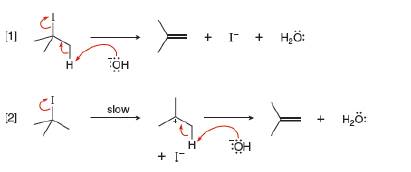
a. What rate equation would be observed for the mechanism in Equation [1]?
b. What rate equation would be observed for the mechanism in Equation [2]?
c. What is the order of each rate equation (i.e., first, second, and so forth)?
d. How can these rate equations be used to show which mechanism is the right one for this reaction?
e. Assume Equation [1] represents an endothermic reaction and draw an energy diagram for the reaction. Label the axes, reactants, products,
f. Assume Equation [2] represents an endothermic reaction and that the product of the rate-determining step is higher in energy than the reactants or products. Draw an energy diagram for this two-step reaction. Label the axes, reactants and products for each step, and the
(a)
Interpretation: The rate equation for the mechanism in Equation [1] is to be stated.
Concept introduction: The rate equation is given as,
The order of reaction depends on the exponents
The rate equation for the reactions in which rate of a reaction depends on one reactant only is given as,
Answer to Problem 6.53P
The rate law equation for the mechanism in Equation [1] is given as,
Explanation of Solution
The mechanism of Equation [1] is shown below.

Figure 1
The above reaction occurs in one step. The hydroxide ion attacks on proton of the starting material. As a result, new double bond formed between two carbon atoms. Iodide ion is expelled out as a leaving group. Therefore, the rate of the reaction relies on the concentration of the starting material and as well as nucleophile. The rate equation for this mechanism is given as,
(a) The rate equation for the mechanism in Equation [1] is given as,
(b)
Interpretation: The rate equation for the mechanism in Equation [2] is to be stated.
Concept introduction: The rate equation is given as,
The order of reaction depends on the exponents
Answer to Problem 6.53P
The rate equation for the mechanism in Equation [2] is given as,
Explanation of Solution
The mechanism of Equation [2] is shown below.

Figure 2
The above reaction occurs in twosteps. In the first step,
Therefore, the rate of the reaction relies on the concentration of the starting material. The rate equation for this mechanism is given as,
The rate equation for the mechanism in Equation [2] is given as,
(c)
Interpretation: The order of each rate equation is to be identified.
Concept introduction: The rate equation is given as,
The order of reaction depends on the exponents
Answer to Problem 6.53P
Theorder of first rate equation is second and the order of second rate equation is first.
Explanation of Solution
The rate law equation for the mechanism in Equation [1] is given as,
The rate equation implies that rate of a reaction relies on the concentration of the starting material and nucleophile. Therefore, it is a second ordered rate equation.
The rate equation for the mechanism in Equation [2] is given as,
The rate equation implies that rate of a reaction relies on the concentration of the starting material only. Therefore, it is a first ordered rate equation.
The order of first rate equation is second and the order of second rate equation is first.
(d)
Interpretation: The use of rate equations to describe which mechanism is the right one for the given reaction is to be stated.
Concept introduction: The rate equation is given as,
The order of reaction depends on the exponents
The rate equation for the reactions in which rate of a reaction depends on one reactant only is given as,
Answer to Problem 6.53P
The equation [2] is the right one for the given mechanism because it involves two steps to complete the reaction.
Explanation of Solution
The equation showing the right mechanism is,

Figure 3
In the above reaction, the starting material is tertiary alkyl halide. In the first step,
Therefore, the equation [2] is the right one for the given mechanism.
The equation [2] is the right one for the given mechanism because it involves two steps to complete the reaction.
(e)
Interpretation: An energy diagram and the structure of the transition state are to be drawn by assuming Equation [1] as an endothermic reaction. The axes, reactants, products,
Concept introduction: The transition state is formed during the conversion of reactants into products in the chemical reaction. In an energy level diagram, it corresponds to the high potential energy along the y-axis. In this state, the dashed bond implies that bonds are partially broken and partially formed in the reaction.
Answer to Problem 6.53P
An energy diagram and the structure of the transition state by assuming Equation [1] as an endothermic reaction is drawn in Figure 4 and Figure 5 respectively The axes, reactants, products,
Explanation of Solution
An energy diagram in which Equation [1] is considered as endothermic reaction is drawn as,
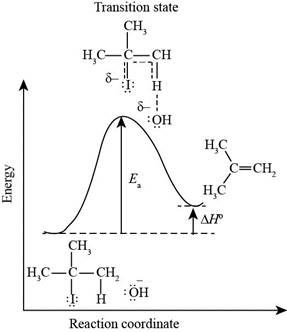
Figure 4
In the energy diagram, reaction coordinate is represented by x-axis and energy is represented by y-axis. The reaction coordinate describes the progress of the reaction. The energy of starting material is low in the diagram as compared to the energy of the product, which indicates that this reaction is endothermic. The minimum energy that is required to form the product from the starting material is represented by
The structure of transition state is,
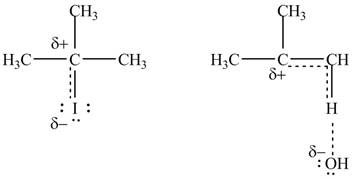
Figure 5
The transition state is formed during the conversion of reactants into products in the chemical reaction. This state cannot be isolated. The dashed bond indicates that bonds are partially broken or formed during the reaction.
An energy diagram and the structure of the transition state by assuming Equation [1] as an endothermic reaction is drawn in Figure 4 and Figure 5 respectively The axes, reactants, products,
(f)
Interpretation: An energy diagram and the structure of the transition state are to be drawn by assuming Equation [2] as an endothermic reaction and the energy of product of the rate-determining step is higher than the reactants or products. The axes, reactants, products,
Concept introduction: The transition state is formed during the conversion of reactants into products in the chemical reaction. In an energy level diagram, it corresponds to the high potential energy along the y-axis. In this state, the dashed bond implies that bonds are partially broken and partially formed in the reaction.
Answer to Problem 6.53P
An energy diagram and the structure of the transition state for Equation [2] is drawn in Figure 6 and Figure 7 respectively. The axes, reactants, products,
Explanation of Solution
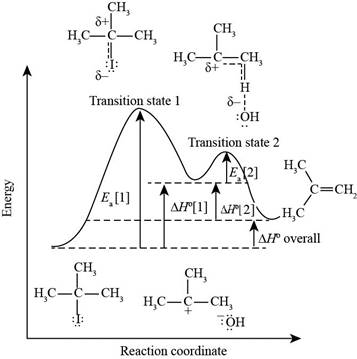
Figure 6
In the energy diagram, reaction coordinate is represented by x-axis and energy is represented by y-axis. The reaction coordinate describes the progress of the reaction. The energy of starting material is low in the diagram as compared to the energy of the product, which indicates that this reaction is endothermic. The minimum energy that is required to form the product from the starting material is represented by
The structure of transition states are,
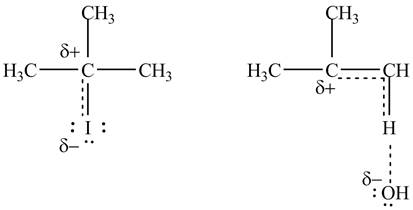
Figure 7
The transition state is formed during the conversion of reactants into products in the chemical reaction. This state cannot be isolated. The dashed bond indicates that bonds are partially broken or formed during the reaction.
An energy diagram and the structure of the transition state for Equation [2] is drawn in Figure 6 and Figure 7 respectively. The axes, reactants, products,
Want to see more full solutions like this?
Chapter 6 Solutions
PKG ORGANIC CHEMISTRY
Additional Science Textbook Solutions
Genetic Analysis: An Integrated Approach (3rd Edition)
Biology: Life on Earth (11th Edition)
Physical Science
Campbell Biology (11th Edition)
- € + Suppose the molecule in the drawing area below were reacted with H₂ over a platinum catalyst. Edit the molecule to show what would happen to it. That is, turn it into the product of the reaction. Also, write the name of the product molecule under the drawing area. Name: ☐ H C=0 X H- OH HO- H HO- -H CH₂OH ×arrow_forwardDraw the Haworth projection of the disaccharide made by joining D-glucose and D-mannose with a ẞ(1-4) glycosidic bond. If the disaccharide has more than one anomer, you can draw any of them. Click and drag to start drawing a structure. Xarrow_forwardEpoxides can be opened in aqueous acid or aqueous base to produce diols (molecules with two OH groups). In this question, you'll explore the mechanism of epoxide opening in aqueous acid. 2nd attempt Be sure to show all four bonds at stereocenters using hash and wedge lines. 0 0 Draw curved arrows to show how the epoxide reacts with hydronium ion. 100 +1: 1st attempt Feedback Be sure to show all four bonds at stereocenters using hash and wedge lines. See Periodic Table See Hint H A 5 F F Hr See Periodic Table See Hintarrow_forward
- 03 Question (1 point) For the reaction below, draw both of the major organic products. Be sure to consider stereochemistry. > 1. CH₂CH₂MgBr 2. H₂O 3rd attempt Draw all four bonds at chiral centers. Draw all stereoisomers formed. Draw the structures here. e 130 AN H See Periodic Table See Hint P C Brarrow_forwardYou may wish to address the following issues in your response if they are pertinent to the reaction(s) you propose to employ:1) Chemoselectivity (why this functional group and not another?) 2) Regioselectivity (why here and not there?) 3) Stereoselectivity (why this stereoisomer?) 4) Changes in oxidation state. Please make it in detail and draw it out too in what step what happens. Thank you for helping me!arrow_forward1) Chemoselectivity (why this functional group and not another?) 2) Regioselectivity (why here and not there?) 3) Stereoselectivity (why this stereoisomer?) 4) Changes in oxidation state. Everything in detail and draw out and write it.arrow_forward
- Calculating the pH at equivalence of a titration 3/5 Izabella A chemist titrates 120.0 mL of a 0.7191M dimethylamine ((CH3)2NH) solution with 0.5501 M HBr solution at 25 °C. Calculate the pH at equivalence. The pk of dimethylamine is 3.27. Round your answer to 2 decimal places. Note for advanced students: you may assume the total volume of the solution equals the initial volume plus the volume of HBr solution added. pH = ☐ ✓ 18 Ar Boarrow_forwardAlcohols can be synthesized using an acid-catalyzed hydration of an alkene. An alkene is combined with aqueous acid (e.. sulfuric acid in water). The reaction mechanism typically involves a carbocation intermediate. > 3rd attempt 3343 10 8 Draw arrows to show the reaction between the alkene and hydronium ion. that 2nd attempt Feedback 1st attempt تعمال Ju See Periodic Table See Hint F D Ju See Periodic Table See Hintarrow_forwardDraw the simplified curved arrow mechanism for the reaction of acetone and CHgLi to give the major product. 4th attempt Π Draw the simplified curved arrow mechanism T 3rd attempt Feedback Ju See Periodic Table See Hint H -H H -I H F See Periodic Table See Hintarrow_forward
- Select the correct reagent to accomplish the first step of this reaction. Then draw a mechanism on the Grignard reagent using curved arrow notation to show how it is converted to the final product. 4th attempt Part 1 (0.5 point) Select the correct reagent to accomplish the first step of this reaction. Choose one: OA Mg in ethanol (EtOH) OB. 2 Li in THF O C. Li in THF D. Mg in THF O E Mg in H2O Part 2 (0.5 point) Br Part 1 Bri Mg CH B CH, 1 Draw intermediate here, but no arrows. © TE See Periodic Table See Hint See Hint ין Harrow_forwardSelect the product for the following reaction. HO HO PCC OH ○ OH O HO ○ HO HO HOarrow_forward5:45 Х Select the final product for the following reaction sequence. O O 1. Mg. ether 2.D.Oarrow_forward
 Chemistry for Today: General, Organic, and Bioche...ChemistryISBN:9781305960060Author:Spencer L. Seager, Michael R. Slabaugh, Maren S. HansenPublisher:Cengage Learning
Chemistry for Today: General, Organic, and Bioche...ChemistryISBN:9781305960060Author:Spencer L. Seager, Michael R. Slabaugh, Maren S. HansenPublisher:Cengage Learning Chemistry: The Molecular ScienceChemistryISBN:9781285199047Author:John W. Moore, Conrad L. StanitskiPublisher:Cengage Learning
Chemistry: The Molecular ScienceChemistryISBN:9781285199047Author:John W. Moore, Conrad L. StanitskiPublisher:Cengage Learning Chemistry: Principles and ReactionsChemistryISBN:9781305079373Author:William L. Masterton, Cecile N. HurleyPublisher:Cengage Learning
Chemistry: Principles and ReactionsChemistryISBN:9781305079373Author:William L. Masterton, Cecile N. HurleyPublisher:Cengage Learning Chemistry by OpenStax (2015-05-04)ChemistryISBN:9781938168390Author:Klaus Theopold, Richard H Langley, Paul Flowers, William R. Robinson, Mark BlaserPublisher:OpenStax
Chemistry by OpenStax (2015-05-04)ChemistryISBN:9781938168390Author:Klaus Theopold, Richard H Langley, Paul Flowers, William R. Robinson, Mark BlaserPublisher:OpenStax Physical ChemistryChemistryISBN:9781133958437Author:Ball, David W. (david Warren), BAER, TomasPublisher:Wadsworth Cengage Learning,
Physical ChemistryChemistryISBN:9781133958437Author:Ball, David W. (david Warren), BAER, TomasPublisher:Wadsworth Cengage Learning,





